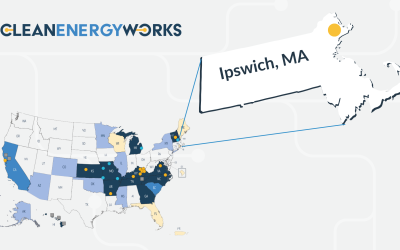To upgrade everything that currently uses fossil fuels, we need financial solutions that are inclusive, fiscally sustainable, and scalable. Neither grants nor loans to energy consumers or building owners have yet met these criteria anywhere.
For decades, policy-makers have believed rebates, tax credits, and lower interest rates would motivate building owners to act. Yet, even with all those inducements, households that have access to cash or credit rarely choose energy upgrades when making home improvements. The result is that the pace of building energy upgrades has been vastly insufficient compared to the scale of the need.
What is more, even where residents are willing to pursue energy upgrades, many of all U.S. households lack the necessary assets and qualifications for loans. The financial services sector is bound to federal rules for access to credit that systematically discourage or disqualify, the 30% with subprime credit scores and the 10% with no credit scores. Add to these the fraction of the 35% of U.S. households who rent and though credit eligible cannot invest in energy upgrades because they do not own the property. In other words, significantly more than 40% of US residents have no choice but to remain tied to fossil fuel energy, a condition that makes attainment of climate change goals almost impossible to imagine.
For decades, the U.S. Congress has repeatedly demonstrated that it will not muster spending on climate action that is commensurate with the challenge. The contrast between existing policies (or even pledged ones) and the necessary scale of investment in building decarbonization illuminates a fundamental mismatch between the size of the climate challenge and the political capital available to deliver responsive public spending.
We need to upgrade more than 100 million buildings in the United States as fast as possible, and that requires us to accept the fact that consumer financial products and public spending have not proven themselves to be effective means of capitalization. Thankfully we have a proven viable alternative….inclusive utility investments.
What are inclusive utility investments?
In an inclusive utility investment [1] program, a utility pays upfront for energy efficiency or clean energy upgrades at a customer’s premises and recovers its costs through a fixed charge for cost recovery on the customer’s utility bill. Building energy upgrades are the most common application, and utilities are increasingly exploring applications in the transportation sector.
Unlike on-bill loan programs [2] or third-party financing [3] and some Residential Property Assessed Clean Energy (R-PACE) [4] programs, inclusive utility investment does not require individual consumer credit checks, and cost recovery obligations are tied to the utility meter rather than the originating customer or as a lien on the property. Upfront payment by a customer is lower and sometimes completely unnecessary, making this approach a more appealing option .
To make an inclusive utility investment, the utility first assesses the safety and soundness of the building. Distressed properties and those with health hazards, such as asbestos, are deferred and ideally referred to appropriate programs for remediation. Remaining homes are assessed solely for their energy savings potential, rather than the customer’s financial liquidity or creditworthiness, thus negating the need for investigating their credit profile, renter vs owner status, or outstanding debt .
After the home energy assessment, the customer is offered their choice of cost-effective upgrade packages. These include replacing or upgrading elements in various building systems such as HVAC, water heaters, or flexible demand response devices. In cases where extensive upgrades are needed to realize energy savings, and consequently where a customer has to contribute a higher upfront copayment, they are frequently offered choices in upgrade packages.
The utility offers to pay the portion of the upfront cost of energy upgrades at a site that can be supported by the stream of energy savings and recovers its costs over time through a fixed monthly charge on the customer’s bill (see Figure 1). The annual cost recovery is set at less than the estimated savings from the upgrades so that the customer immediately enjoys moderately lower energy costs and notably lower costs after the utility recovers all of its costs and ends the charge. Importantly, the monthly charge automatically applies to future customers at that site and does not follow the originating customer the way a personal loan would. At the time the utility realizes the full recovery of its investment, the upgrades belong to the building owner.
 Figure 1. Flow of capital in a typical inclusive utility investment.
Figure 1. Flow of capital in a typical inclusive utility investment.
Those utilities that were early adopters of inclusive utility investment found that they provided access to energy upgrades for many customers that would not otherwise have sought or been able to afford them, even in regions with persistent poverty.
It is critical that inclusive utility investments are structured to not only ensure that customers have low or no upfront payments but to also provide strong consumer protections. Utilities and third party program operators have developed turnkey processes to manage program quality. Examples of such quality control measures include negotiating volume pricing in advance with installation contractors, conducting sound energy savings assessment, offering only cost-effective upgrades, and active oversight to guarantee quality upgrade installations. The customer must simply enroll, agree to an assessment and accept an offer and everything else is taken care of. Upon enrolling in the program and agreeing to proceed with the offered package of upgrades, a customer can rest assured that quality work will be performed without them having to manage contractors. In the case of faulty equipment, all monthly utility cost recovery charges stop until the utility meets its obligation to repair or replace such equipment.
Pay As You Save®: the prevailing system for inclusive utility investment
In 1999 the Energy Efficiency Institute, Inc (EEI) invented and trademarked the first example of inclusive utility investment under the trademark Pay as You Save® (PAYS®). As of January 2023, all active inclusive utility investment programs except for those in Vermont use a version of the Pay As You Save system and licensed intellectual property from EEI. [5] PAYS thus provides the prevailing system for tariff and program architecture that makes a program inclusive and ensures significant consumer protections.
These protections include capping the site-specific charge to be less than the estimated savings from energy cost reductions and assuring a path to ownership for the site owner once the utility’s costs are recovered. The Vermont programs replicate nearly all of the features of Pay As You Save except that there is no disconnection for non-payment of the tariffed charge and the investment is made by the state housing finance authority rather than the utility.
Utilities and program operators implementing PAYS have provided further enhancements such pre-negotiated contractor pricing and real time remote installation quality assurance, that substantially improved consumer protections. In 2021 EEI granted an exclusive license to use the PAYS intellectual property for residential and small commercial buildings to EEtility, the only interstate program operator and originator of the key program implementation innovations. The licensing agreement does not, however, preclude others from using the PAYS trademark but does require them to develop their own set of interlocking legal documents and obtain acknowledgement from EEI that these meet the PAYS Essential Elements and Minimum Program Requirements. At present states and utilities rather than seeking to use the PAYS trademark have proposed or implemented self-branded program designs incorporating many but not all of the features of PAYS.
Interest in inclusive utility investment is accelerating
Increasingly, utilities are recognizing the benefits that inclusive utility investments provide to expected energy savings, management of grid services, and to their financial rate of return. As a result, the utility is especially motivated to manage the entire process to ensure upgrades are installed correctly in order to produce projected site-specific savings and other benefits.


Customer enrollment rate for PAYS® programs is dramatically higher than for green or utility loan programs. Field data has shown that customers accept upgrade offers through inclusive utility investment programs 70-90% of the time when there are no or low copayments, compared to less than 10% for typical loan programs, even with no upfront copayments. That difference is seen across all income levels. Customers at any income level appear to be more likely to install building energy upgrades through an inclusive utility investment program than a debt-based one
Inclusive utility investment is a paradigm shift from the way utilities have historically viewed their services because most utilities and their regulators have not seen efficiency and on-site clean energy programs as central to their core business. With inclusive utility investments, utilities treat cost-effective building energy upgrades as part of the essential services they deliver and a productive part of their business model.
Utilities already have a relationship with the occupants of virtually every building in the country. They can leverage this expansive customer base to access low-cost capital for upgrade investments on terms determined to be just, reasonable, and fair by their regulators or oversight boards. Thus, inclusive utility investments make it financially possible and attractive for utilities to capitalize building electrification and efficiency upgrades on the same scale as conventional power plants but at much lower cost.
______________________________
Endnotes
1 In 2021, the US Environmental Protection Agency adopted inclusive utility investment as an umbrella term for programs meeting the Pay As You Save® standard (see below) for energy savings and strong consumer protections is””. Historically, similar programs have also been called “on-bill tariff”, “tariffed on-bill investments”, “inclusive financing”, or “on-bill finance”. However, these terms are often applied to utility programs that lack many, if not most, of the consumer protections guaranteed by PAYS® and therefore these programs are not considered inclusive utility investments.
2 On-bill loan programs also called on-bill repayment pay for energy efficiency or clean energy upgrades through a 3rd party lender with monthly repayments collected by the utility bill . In this model the loan is tied to the individual customer typically using traditional underwriting criteria such as credit score and income.
3 Third-party financing programs are marketed by utilities, but rely on capital provided by a third party lender who provides underwriting services and qualifies the property owner for upgrades, but in this case the loan is repaid through a separate bill. In this model, the utility serves primarily as a marketing and payment collection partner.
4 R-PACE programs establish a lien on the property that is superior to the mortgage with payments collected by the local tax authority as part of property tax assessments. These loan programs are largely unregulated. Although positioned and marketed like PAYS i.e. “your energy savings paying for upgrades,” they lack key consumer protections and have resulted in consumer fraud, abuse, and forced property sales to recover the investment. R-PACE programs are offered in three states: California with restrictions and bans in some municipalities, parts of MO, and in FL. The federal Consumer Financial Protection Bureau issued an advanced notice of proposed rulemaking on protective regulation of PACE programs.
5 As of 2022, 20 U.S. utilities in 10 states have invested over $43 million to upgrade more than 5,400 locations using the Pay As You Save® approach. Source: https://www.eeivt.com/status-reports/. The PAYS® model has also been applied to LED lighting and other efficiency upgrades in India by Energy Efficiency Services Limited (EESL), a state-run super-Energy Service Company (ESCO) that has collaborated with utility distribution companies. Source: https://eeslindia.org/wp-content/uploads/2020/10/CorporateBrochure_2019.pdf.
How do I learn more?
Clean Energy Works provides technical assistance to utilities, regulators, community members, and other stakeholders interested in exploring an inclusive utility investment program.
For more information:




